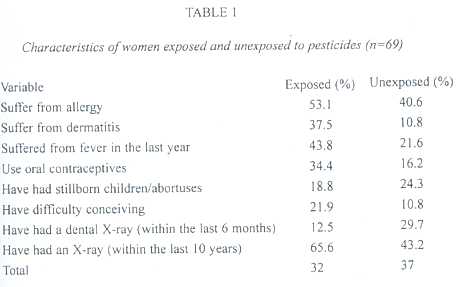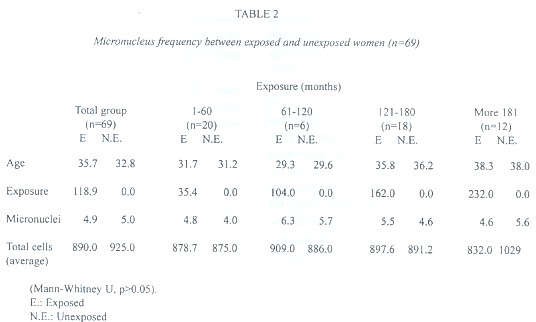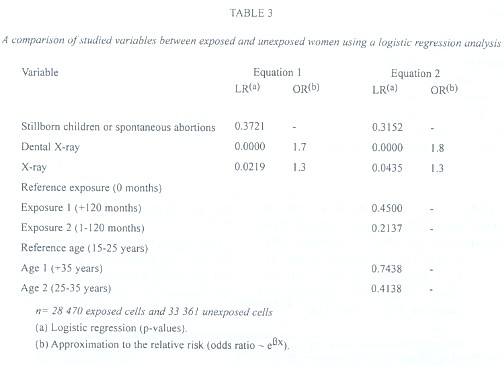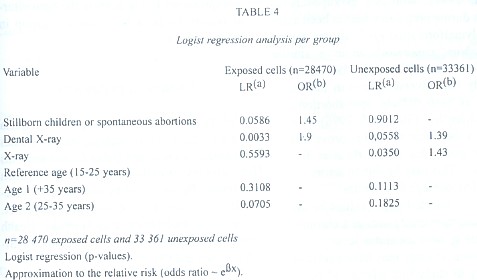Services on Demand
Journal
Article
Indicators
-
 Cited by SciELO
Cited by SciELO -
 Access statistics
Access statistics
Related links
-
 Similars in
SciELO
Similars in
SciELO  uBio
uBio
Share
Revista de Biología Tropical
On-line version ISSN 0034-7744Print version ISSN 0034-7744
Rev. biol. trop vol.49 n.1 San José Mar. 2001
Micronuclei frequency in lymphocytes of individuals occupationally exposed to pesticides
Recibido 18-I-2000. Corregido 25-VIII-2000. Aceptado 19-IX-2000.
Abstact
Pesticides have been widely used in developing countries over the years. A large amount of these remains in the environment and organisms. Pesticide pollution is detrimental to human health. The effects can be seen on a short or a long-term basis and the symptoms can vary from headache to cancer. Only a minority of studies focuses on their genotoxic effect. This study assesses the genotoxic effect of the pesticides used at banana-packaging plants with binucleate micronuclei assay using cultured lymphocytes. The studied population included 32 exposed and 37 unexposed women from Costa Rica. There is no significant difference between the two groups. However, women who worked at the packaging plant and had stillbirths or spontaneous abortions were 1.45 times more (Key words: Micronuclei, lymphocytes, pesticides, human population, biomonitoring, banana workers, women.
The micronucleus assay in cultured lymphocytes to screen chromosome aberrations and to detect clastogenic and aneuploidogenic agents (Eastmond & Tucker 1989, Sorsa et al. 1992, Fenech 1993a, b) is a relatively rapid and straightforward (Marzin 1997). Micronuclei are formed by the condensation of acentric chromosomal fragments or by whole chromosomes, which have had a lagging movement during anaphase and consequently are excluded postmitotically from daughter cells and form small nuclei or micronuclei (Sorsa 1984, Carrano & Natarajan 1988, Tucker & Preston 1996).
Studies about micronuclei frequency have been carried out in populations exposed to ionizing radiation, smokers, gas stations workers, workers exposed to pesticides, styrene and ethylene oxide. It has also been used to assess other environmental mutagens (Ribeiro et al. 1994, Carere et al. 1995, Anwar & Shamy 1995, Scarpato et al. 1996a, b). The pesticide rotenone increases the micronuclei frequency in human lymphocytes and causes a delay in the cell cycle. The presence of metabolic activation system (S9 mix) reduces its genotoxic activity (Guadano et al. 1998). Fenech et al. 1997 have done a micronucleus study in children from regions of Belarous that are contaminated by radionucleotides and compared their frequency with those living in non contaminated areas. Preliminary data indicate a significant two to four-fold increase in micronucleus expression in exposed children. In people exposed to ionizing radiation in Brazil, indicated an increase in micronuclei frequencies strongly correlated ionizing radiation dosage (Da Cruz et al. 1994). Falck et al. 1999, used the frequency of micronuclei in cultured peripheral lymphocytes as a biomarker for genotoxic effects in 34 Italian, pesticide-exposed greenhouse workers, and 33 unexposed referents matched by age and smoking habits. Higher mean micronuclei frequencies were detected among exposed smokers than in smoking referents. In multiple regression analysis considering age, sex, smoking and genotypes (for GSTM1, GSTT1 and NAT-2 polymorphisms) there were significant elevations of micronuclei frequencies in greenhouse workers, especially in those spraying pesticides. Josick et al. 1997 studied the frequency of micronuclei in 27 vineyard growers exposed to pesticides. This test was performed during the prespraying period, a month after spraying and later on. There were two control groups: 15 individuals from a nearby town, and 20 volunteers living 200 kilometers from the vine-growing area. During the prespraying period no statistically significant (p<0.5) differences in micronuclei yielding were found. The incidence of micronuclei a month after spraying in exposed subjects was elevated (statistically significant at p<0.01) in comparison with the prespraying period. At the end the micronuclei frequency was significantly higher (p< 0.0001) in the exposed group than in both control groups.
The aim of the present work was to assess the genotoxic effect of the pesticides used by female workers in banana-packing plants.
The exposed group comprises 32 women who had worked for at least 4 consecutive months in any of 15 banana farms of the region. They were mainly exposed to imalzalile and thiabendazole, (fungicides) and chlorpyriphos (organophosphorus insecticide). They were working in the selecting, spraying, and branding of banana. The participation response rate was approximately 70%. The Department of Toxic Substances and Labor Medicine of the Health Ministry authorized access to the farms.
The unexposed group had 37 women from the same region without occupational exposure to pesticides matched to the exposed ones according to variables such as age, smoking, diet, viral infections, vaccination, and alcohol and drug consumption (Anonymous 1985, Carrano & Natarajan 1988, Sorsa et al. 1992, Fenech 1993a, Bolognesi et al. 1997). They were women who happened to visit the Guápiles Hospital and the Health Care Center or worked there, as clerks or nutrition personnel. The response rate was approximately 30%.The data were collected from January 1996 to June 1996 and from January 1997 to June 1997. The relative exposure time had been equal during all year since the banana production is constant.
Sample collection: A 10 ml blood sample per individual was collected in sterile heparin vacutainers. Samples were transported at 4ºC to the Institute and peripheral blood cultures were set up during the following 24 hours.The culture medium, serum, and reagents belonged to the same lot (Anonymous 1985).All laboratory work and microscope analysis was double-blind.
Cell culture: 0.5 ml whole-heparinized blood was cultured in 5 ml of RPMI 1640 supplemented with 20% fetal bovine serum, 50 ml L-glutamine, antibiotics, and 1.0% phytohemagglutinin. Tubes were incubated at 37ºC and 44 hours later 37.5 *l of cytochalasin-B were added to each tube (final concentration 3.0 mg/ml). At 72 hours, a gentle fixation of methanol/acetic acid (3: 1) was made. Cell suspensions were dropped from each tube onto five clean and cold slides; from a 2-3 cm distance and a slide inclination of 45º. Slides were allowed to air dry and incubated at 60ºC overnight. They were stained with Wright-Giemsa (modified from Schmid 1975).
The microscope analysis was done by counting the micronuclei found in 800 to 1100 binucleate cells per person with a relatively intact cytoplasm, according to Schmid 1975, Högsted 1984, Fenech & Morley 1985a, b, Fenech 1993a, b.
Statistical analysis: Data analysis was first done with the whole population. Both groups (exposed and unexposed one) were matched by age with ± 2 years.
The micronuclei frequency in lymphocytes from both groups was compared using the Mann Whitney-Wilcoxon test. Logist regression was used to identify womens characteristics associated with frequency of micronucleus. The number of observations corresponds to the total number of cells studied. The dependent variable corresponds to micronuclei frequency in human lymphocytes. The independent variables correspond to personal habits, exposure to chemical substances, medication, radiation exposure and others. These variables were taken into account in the questionnaire given to each of the studied subjects.
The equation consists of micronucleus assay taking into account the following variables: stillborn children, dental X-ray, other X-rays, exposure 1, exposure 2, age 1, and age 2l. The dependent variable is coded as 1 if micronuclei were present and 0 otherwise.The equation 1 evaluated the following variables: stillborn children, dental X-ray, other X-rays; and the equation 2 contained: stillborn children, dental X-ray, other X-rays, exposure 1, exposure 2, age 1, and age 2.
l Exposure and age were recoded as follow: exposure1: women exposed during more than 120 months, exposure2: women exposed from 1 to 120 months, reference exposure: 0 months of exposure. Age1: women older than 35 years, age2: women between 25 and 35 years, reference age: women younger than 25 years.
Results
Table 1 shows the descriptive statistic of the study population.

There was no difference in micronuclei (Mann-Whitney test U, p>0.05, table 2). Pairs were separated according to exposure categories for a second test as follows: group 1 (1-14 months of exposure), group 2 (61-120 months), group 3 (121-180 months), and group 4 (more than 180 months), but again no statistically significant difference was found (table 2).
A logistic regression suggest that exposure to dental X-rays and exposure to X-rays within the past ten years constitute the variables influencing micronuclei appearance for this population.

Table 3 (equation 1) shows that women exposed to dental X-rays have a 1.7 odds ratio when compared with women who have never been exposed. Women exposed to X-rays show a 1.3 odds ratio. When exposure and age are included (Table 3, equation 2), values remain almost identical.

When the same variables are analyzed in other way – women exposed to pesticides versus unexposed ones- (Table 4), the results vary slightly. Those exposed who have had stillborn children or spontaneous abortions are 1.45 times more likely to have micronuclei than those women exposed that have not had these conditions. This risk does not exist among unexposed, women with stillborn children or spontaneous abortions. Exposure to dental X-rays had an influence on micronucleus frequency in exposed and unexposed women. However, this odds ratio is higher among exposed women. Regarding the X-rays, only unexposed women present a higher odds ratio for micronuclei.

Discussion
Some conflicting results regarding genetic monitoring of populations exposed to pesticides are due to multiple exposures, different types of pesticides, or the heterogeneous composition of the population (Scarpato et al. 1996a, b).
It is important to emphasize that in this study the unexposed group is indirectly exposed to pesticides (because some farms are next to downtown), this may increase their micronuclei frequency, which in turn may explain the homogeneity among the groups.
This evidence suggest that the general population is exposed to pesticides. A study that compares the levels of cholinesterase between women exposed to pesticides and unexposed women by Cuenca et al. 1997 reveals that this last group has a decreased level of cholinesterase, and this effect is not due to any hepatic or another kind of problem.
People who work with pesticides are the most exposed to these, the general public comes in contact with them during air fumigation (Steenland 1996, García 1997). It is also possible that the population of Pococí receives pesticides from water wind or water (Blanco & Ramírez 1992). Furthermore, many use domestic pesticides at least once a month (Castro 1999) and most of the studied population has been exposed to other agents such as ionizing radiation and dental X-rays that affect micronuclei (Norppa et al. 1993, Fenech 1993a).
Among women exposed to pesticides micronuclei frequency is higher in those who have had spontaneous abortions and/or stillborn babies. This may be related to individual differences in susceptibility to genotoxic agents. It is then possible that the first group is the most susceptible to chromosome breakage and damage to the mitotic spindle apparatus.
Some pesticides (such as DBCP, 2, 4-D, 2, 4, 5-T) increase the risk of spontaneous abortions as well as congenital malformations, preterm births, and infertility (Jaffery & Viswanathan 1986, Hilje et al. 1987) among women who are occupationally exposed (Savitz et al. 1994). Womens exposure to chlorpyriphos during pregnancy has been associated to a polymalformation syndrome among newborns. Laboratory animals have similar malformations (Sherman 1996, 1995). Aneuploidy has adverse effects on human health, such as birth defects, spontaneous abortions, and infertility (Tucker & Preston 1996). Our results show that it is not possible to prove that those pesticides affect the micronuclei frequency. This may be due to several factors:
The damage is at another level.
The selected target cells might not be the most appropriate to see an effect at a chromosome or mitotic spindle apparatus level.
The micronuclei assay may have a relative low sensitivity to study this mixture of pesticides.
These enter the organism mainly through skin, which does not produce a measurable damage at micronuclei level. In laboratory animals, the oral and intraperitoneal treatments with chlorpyriphos induces a high percentage of polychromatic erythrocytes with micronuclei, which do not occur when this insecticide is dermatologically administered (Armer & Fahmy 1982). Because of the physical-chemical characteristics of the pesticides in question, they are not easily absorbed by the organism or are rapidly eliminated. The chlorpyriphos and the imalzalile have little solubility in water.
The dose of pesticides is not high enough to induce micronuclei in peripheral blood lymphocyte. It may be that womens exposure consists of low and repeated doses, so that the level of intensity capable of increasing micronuclei frequency is not achieved.
The pesticide behavior in the environment is evident: 98% of pesticides used are distributed in the environment at all levels (García 1997), so that the unexposed women are also exposed to pesticides because they live in the region.
In conclusion, pesticides used in the banana-packaging plant do not influence the frequency of micronuclei in these working women; however, it is possible that there is another type or level of genetic damage. An unexposed group living outside the agricultural region would be a better control group in future studies.
Acknowledgments
We thank the INISA staff, specially Rafaela Sierra for administrative support, Arodys Robles for statistical support and Isabel Castro and Luis Herrera for review of this paper. This investigation was financially supported by the Research Vice-presidency University of Costa Rica (project N. 742-95-277), FUNDEVI, Pan-American Health Organization through the PLAGSALUD/MASICA Program and CONICIT.
References
Amer, S.M. & M.A. Fahmy. 1982. Cytogenetic effects of pesticides. I. Induction of micronuclei in mouse bone marrow by the insecticide Dursban. Mut. Res. 101: 247-255. [ Links ]
Anonymous. 1985. Guidelines for the study of genetic effects in human populations. Environmental Health Criteria 46, 126 p. World Health Organization, Geneva. [ Links ]
Anwar, W.A. & M.Y. Shamy. 1995. Chromosomal aberrations and micronuclei in reinforced plastic workers exposed to styrene. Mut. Res. 327: 41-47. [ Links ]
Blanco, J. & O. Ramírez. 1992. La contaminación por plaguicidas percibida por los inspectores de saneamiento ambiental. Rev. Ciencias Amb. 9: 59-68. [ Links ]
Bolognesi, C., A. Abbondandolo, R. Barale, R. Casalone, L. Dalprá, M. De Ferrari, F. Degrassi, A. Forni, L. Lamberti, R. Pasquini, R. Puntoni, I. Sbrana, A. Stella & S. Bonassi. 1997. Age-related increase of baseline frequencies of sister chromatid exchange, chromosome aberrations, and micronuclei in human lymphocytes. Cancer Epidemiol. Bio. Prev. 6: 249-256. [ Links ]
Carere, A. A. Antoccia, R. Crebelli, F. Degrassi, M. Fiore, I. Iavarone, G. Isacchi, S. Lagorio, P. Leopardi, F. Marcon, F. Palitti, C. Tanzarella & A. Zijno. 1995. Genetic effects of petroleum fuels: cytogenetic monitoring of gasoline station attendants. Mut. Res. 332: 17-26. [ Links ]
Carrano, A. & A. Natarajan. 1988. Considerations for population monitoring using cytogenetic techniques. Mut. Res. 204: 379-406. [ Links ]
Castro, R. 1999. Análisis de micronúcleos del epitelio oral en trabajadoras de una zona bananera expuestas a plaguicidas. Tesis para obtener el grado de Licenciatura en Biología, Universidad de Costa Rica, San José, Costa Rica. 101p. [ Links ]
Cuenca, P., V. Ramírez, R. Castro & K. Schosinsky. 1997. Efecto genotóxico de los plaguicidas en una población ocupacionalmente expuesta. Evaluación por medio de micronúcleos de linfocitos y del epitelio bucal, aberraciones cromosómicas, mecanismos de reparación y electroforesis de células únicas; controlando paralelamente los niveles de colinesterasa sérica y eritrocítica. Informe final presentado ante el proyecto PLAGSALUD/MASICA. San José, Costa Rica, 62 p. [ Links ]
Da Cruz, A.D., A.G. Mc Arthur, C.C. Silva, M.P. Curado & B.W. Glickman. 1994. Human micronucleus counts are correlated with age, smoking, and cesium-137 dose in the Goiânia (Brazil) radiological accident. Mut. Res. 313 : 57-68. [ Links ]
Eastmond, D.A. & J.D. Tucker 1989. Identification of aneuploidy-inducing agents using cytokinesis-blocked human lymphocytes and an antikinetochore antibody. Environ. Mol. Mut. 13: 34- 43. [ Links ]
Falck, G.C, A. Hirvonen, R. Scarpato, S.T. Saarikoski, L. Migliore & H. Norppa. 1999. Micronuclei in blood lymphocytes and genetic polymorphism for GSTM1, GSTT1 and NAT2 in pesticide-exposed greenhouse workers. Mut. Res. 441: 225-237. [ Links ]
Fenech, M. & A. Morley. 1985a. Measurement of micronuclei in lymphocytes. Mut. Res. 147: 29-36. [ Links ]Fenech, M. & A. Morley. 1985b. The effect of donor age on spontaneous and induced micronuclei. Mut. Res. 148: 99-105. [ Links ]
Fenech, M. 1993a. The cytokinesis-block micronucleus technique and its application to genotoxicity studies in human populations. Environ. Health Perspect. 101: 101-107. [ Links ]
Fenech, M. 1993b. The cytokinesis-block micronucleus technique: A detailed description of the method and its application to genotoxicity studies in human populations. Mut. Res. 285 : 35-44. [ Links ]
Fenech, M., G. Perepetskaya & L. Mikhalevich. 1997. A more comprehensive application of the micronucleus technique for biomonitoring of genetic damage rates in human populations experiences from the Cherbonyl catastrophe. Environ. Mol. Mut. 30: 112-118. [ Links ]
García, J. 1997. Introducción a los plaguicidas, 476 p, EUNED, San José, Costa Rica. [ Links ]
Guadano, A., A. González-Coloma & E. de la Peña. 1998. Genotoxicity of the insecticide rotenone in cultured human lymphocytes. Mut. Res. 414: 1-7. [ Links ]
Hilje, L., L. Castillo, L. Thrupp & I. Wesseling. 1987. El uso de los plaguicidas en Costa Rica, 159 p. Universidad Estatal a Distancia. San José, Costa Rica. [ Links ]
Högstedt, B. 1984. Micronuclei in lymphocytes with preserved cytoplasm. A method for assessment of cytogenetic damage in man. Mut. Res. 130: 63-72. [ Links ]
Jaffery, F. & P. Viswanathan. 1986. Women workers as specific high risk group in occupational y Environmental Toxicology. J. Sci. Ind. Res. 45: 109-118. [ Links ]
Joksic, G., A. Vidakovic & V. Spasojevic-Tisma. 1997. Cytogenetic monitoring of pesticide sprayers. Environ. Res. 75: 113-118. [ Links ]
Kligerman, A.D. & G.L. Erexson. 1999. An evaluation of the feasibility of using cytogenetic damage as a biomarker for alachlor exposure. Mut. Res. 441: 95-101. [ Links ]
Marzin, D. 1997. The position of the in vitro micronucleus test within the battery of screening for genotoxic potential determination and the regulatory guidelines. Mut. Res. 392: 175-181. [ Links ]
Norppa, H., Luomahaara S., H. Heikanen, S. Roth, L. Renzi & C. Lindholm. 1993. Micronucleus assay in lymphocytes as a tool to biomonitoring human exposure to aneuploidogens and clastogens. Environ. Health Perspect. 101: 139-143. [ Links ]
Ribeiro, L.R., D.M.F. Salvadori, A.C.C. Rios, S.L. Costa, A.D. Tates, M. Törnqvist & A.T. Natarajan. 1994. Biological monitoring of workers occupationally exposed to ethylene oxide. Mut. Res. 313: 81-87. [ Links ]
Savitz, D., N. Sonnenfeld & A. Olshan. 1994. Review of epidemiologic studies of paternal occupational exposure and spontaneous abortion. Am. J. Ind. Med. 25: 361-383. [ Links ]
Scarpato, R., L. Migliore, G. Angotzi, A. Fedi, L. Miligi & N. Loprieno. 1996a. Cytogenetic monitoring of a group of Italian floriculturists : no evidence of DNA damage related to pesticide exposure. Mut. Res. 367: 73-82. [ Links ]
Scarpato, R., L. Migliore, A. Hirvonen, G. Falck & H. Norppa. 1996b. Cytogenetic monitoring of occupational exposure to pesticides : Characterization of GSTM1, GSTT1 and NAT2 genotypes. Environ. Mol. Mut. 27: 263-269. [ Links ]
Schmid, W. 1975. The micronucleus test. Mut. Res. 31: 9-15. [ Links ]
Sherman, J. 1995. Chlorpyrifos (Dursban) associated birth defects: A proposed syndrome, report of four cases and discussion of the toxicology. Internat. J. Occup. Med. & Toxicol. 4: 417-431. [ Links ]
Sherman, J. 1996. Chlorpyrifos (dursban) associated birth defects: Report of four cases. Arch. Environ. Health. 51: 5-8. [ Links ]
Sorsa, M. 1984. Monitoring of sister chromatid exchange and micronuclei as biological endpoints, p. 339-349. In Berlin, A., M. Draper, K. Hemminki & H. Vainio (eds.). Monitoring human exposure to carcinogenic and mutagenic agents. IARC Scientific, Lyon, France. [ Links ]
Sorsa, M., J. Wilbourn & H. Vainio. 1992. Human cytogenetic damage as a predictor of cancer risk, pp. 543-554. In Vainio H., P. Magee,D. McGregory A. McMichael (Eds.). Mechanisms of carcinogenesis in risk identification. IARC Scientific Publications, Lyon. [ Links ]
Steeland, K. 1996. Chronic neurological effects of organophosphate pesticides. BMJ. 312: 1312-1313. [ Links ]
Tucker, J.D. & R.J. Preston. 1996. Chromosome aberrations, micronuclei, aneuploidy, sister chromatid exchanges, and cancer risk assessment. Mut. Res. 365: 147-159. [ Links ]
1 Instituto de Investigaciones en Salud (INISA). Universidad de Costa Rica. Fax: 506 207 5130.E-mail: vramirez@cariari.ucr.ac.cr














